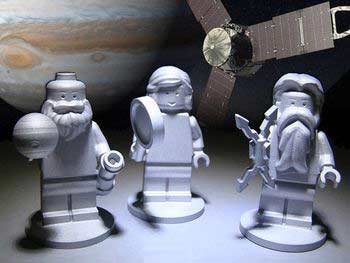It was a do-or-die mission for Juno, Nasa's spacecraft which reached Jupiter after a five-year journey through deep space. Juno, named after the Greek god Jupiter's wife, hopes to reveal secrets that the solar system's largest planet hides beneath a cloud of gas.
Here are a few facts you must know about the Juno mission.
Getting to know the big boy: The fifth planet from the sun, Jupiter is the largest planet in the solar system. Known as a gas giant, Jupiter is really just a ball of hydrogen and helium. Believed to have been the first planet to form shortly after the sun, Jupiter may hold the key to understanding how earth and the rest of the solar system developed. Scientists are hoping to use Juno data to map the planet’s magnetic and gravitational fields and reveal information about its internal structure, atmosphere and water. They also hope to learn more about the planet's northern and southern lights which have mesmerised scientists forever.
Most distant solar-powered spacecraft: Juno beats Europe's Rosetta spacecraft to become the first spacecraft to venture the farthest into deep space, solely powered by the sun. A trio of massive solar arrays will generate 500 watts of power to run nine instruments in the spacecraft.
Fastest spacecraft: Juno is also the fastest spacecraft to ever venture into the solar system. The spacecraft is travelling at a speed of more than 2,41,000 km/hr, which is nearly a quarter of a million km/hr, making Juno one of the fastest man-made objects. If all goes as planned, Juno will circle Jupiter 37 times over 20 months, diving down to about 4,100 kilometres above the planet's dense clouds.
 (L to R) LEGO figurines representing the Roman god Jupiter, his wife Juno and Galileo Galilei | NASA
(L to R) LEGO figurines representing the Roman god Jupiter, his wife Juno and Galileo Galilei | NASA
There are passengers, too! Unusual for a robotic space mission, Juno is carrying three passengers—specially designed LEGO figurines representing the Roman God Jupiter, his wife Juno and Galileo Galilei, who made several important discoveries about Jupiter, including the four largest satellites of Jupiter. The figurines are made of aluminium to withstand the extreme conditions of space travel. These are part of the Bricks in Space project, the joint outreach and educational programme developed as part of the collaboration between NASA and the LEGO group to inspire children to explore science, technology, engineering, and mathematics.
A verified twitter account: One of the perks of living in the digital age—even our spaceships have social media accounts! Juno's twitter feed is filled with witty mission updates and pictures of ground control. After landing, the following tweet was published: '@NASAJuno: Engine burn complete and orbit obtained. I'm ready to unlock all your secrets, #Jupiter. Deal with it.'
Dramatic death for Juno: At the end of its mission in 2018, Juno will deliberately dive into Jupiter's atmosphere and disintegrate. This purposeful death was planned to prevent any chance of it accidentally crashing into the planet's potentially habitable moons.
—with Teresa Cherukara


